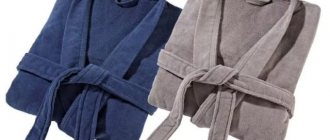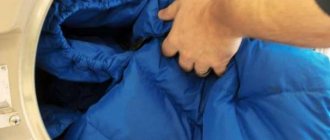A soft, warm blanket is associated with comfort, coziness and silence. It’s so nice on a cold winter evening, sitting comfortably in a rocking chair and covered with a fluffy blanket, reading an interesting book or watching your favorite movie. However, any textile becomes dirty over time, and then the housewife has a question: how to wash a blanket correctly? How you clean this bulky product depends on the material it is made from.
Which product can be washed?
Cleaning any textile begins with reading the manufacturer's care information on the label. Not so long ago, the word “plaid” meant a thick blanket made of wool, cashmere or alpaca, knitted by hand, which could only be washed by hand. Today on sale you can find similar products made from cotton and linen, fleece and polyester, microfiber and bamboo. All of them are industrially manufactured using the latest technology and durable dyes and are easily machine washable.
The choice of cleaning method depends on the following factors:
- composition of the fabric from which the textiles are made;
- the presence of complex dirt and stains;
- dye fastness;
- product volume.
Usually, only thin small blankets made of lightweight materials are machine washed: nylon, polyester, fleece.
The main thing is that there is enough free space left in the drum after the item that needs cleaning is placed there. To wash a blanket as rarely as possible, it must be stored correctly:
- in a paper or fabric bag with good ventilation (not in a plastic bag);
- fold into a roll to avoid creases;
- protect from moths.
Usually such things are washed 2-3 times a year. It is better to clean local stains using a stain remover or by washing the stained area with laundry soap.
Machine washable
If the blanket is small and easily fits into the drum, it is placed in a special bag before washing. The mode is set depending on the type of fabric and the manufacturer’s recommendations. If the label is lost, install a delicate wash.
The optimal temperature for such things is up to 30 degrees. If possible, turn off the spin or select a gentle one, at 500 rpm. It is better to avoid drying altogether. After finishing the wash, turn on 2-3 additional rinse cycles.
Liquid products are used to clean blankets. They penetrate fabric fibers better than powders and are washed out well without leaving white marks. For bright materials, choose a gel for delicate fabrics that contains enzymes that preserve color. Do not use bleaching agents.
Woolen blankets, capes and bedspreads
A wool blanket is a classic option. Warm, comfortable, durable, breathable. Sometimes, in order to refresh textiles made from natural wool, it is enough to air it for a while by hanging it outside or on the balcony. If the product is heavily soiled, it can be washed at home, although this is not an easy job. Despite the fact that many washing machines have a “Wool” mode, it is not advisable to use the machine. It is better to do a gentle hand wash.
First of all, you need to decide on a detergent. Experts advise using a special gel for washing woolen products. It washes clothes well in not too hot water and washes out well when rinsed. Instead of gel, you can use baby soap or regular hair shampoo. Soap is made into small shavings, which are thoroughly dissolved in water. The main thing is to achieve abundant foam. When rinsing the blanket, so that it remains soft and fluffy, add conditioner to the water.
We recommend: 6 types of clothes that should not be put in the washing machine
Hand washing a wool blanket is carried out as follows:
- fill a large container (basin or bath) with water whose temperature does not exceed 30°C;
- add detergent and whip up rich foam;
- soak the item for 15 minutes;
- wash with light progressive movements, then pulling out, then plunging back into the liquid;
- Rinse the item several times in cool water, adding conditioner during the last rinse.
In order not to damage the structure of the wool fiber, the product is not wrung out or twisted.
After washing, the blanket is removed from the water and laid out on a wire rack installed above the bathtub. When the water has drained, the product can be dried with a towel and then laid out to dry.
The drying area must be prepared in advance. A blanket is spread on the floor or a large table, on which the wet product is laid out. To prevent the blanket from warping and shrinking in size, it can be secured with pins around the perimeter.
Silk and cashmere products are also recommended to be washed only by hand, and not twisted or wrung out.
Rules for washing polyester and acrylic bedspreads in the washing machine
Acrylic blankets are durable, beautiful, and last a long time if used correctly.
Label for a polyester blanket indicating instructions for caring for the product
- Choose the lowest possible; temperature regime (up to 30C) for delicate fabrics.
Delicate machine wash mode at 30 degrees - Use liquid powder and fabric softener to avoid white streaks and reduce electrostatic properties. Fill the air conditioner with freshness and softness.
There are special products for washing blanketsFabric softeners will make the blanket soft and smell nice
- In the automatic machine program, select “manual mode” or “synthetic”.
- Set the spin to minimum.
Manual cleaning of acrylic and polyester blankets is not an easy task. Please note that these items take on a lot of water, making them difficult to lift and carry.
For hand washing you need:
- fill the bathroom with water (up to 30C);
- Add powder;
- Soak for at least 10 minutes;
- Perform manipulations with light movements for 5-10 minutes;
- Drain the water and add new water, repeat the rinsing process several times;
- Add fabric softener and rinse again;
- Drain the water, hang it over the bathtub and let it drain;
- Take it to the balcony and hang it, avoiding direct sunlight.
Hand washing a blanket in the bathroom
Rules for washing synthetic blankets
Along with woolen blankets, products made from synthetic and artificial materials are very popular: fleece, microfiber, polyester, fur. Such textiles are much cheaper, but they cope with their duties - to warm and give comfort.
You can wash synthetic bedspreads either in a machine or by hand. The main thing is to find out the permissible water temperature from the information on the label before starting the process. Typically this value ranges from +30°C to +60°C.
When washing by hand, you should follow the same rules as when cleaning a wool blanket. Only spinning in the case of synthetics can be treated less carefully. A product made of polyester or microfiber can be slightly wrung out, this will not damage the material or destroy the structure of the fibers.
You can wash a large blanket in the machine using the following algorithm:
- the product is placed in a drum without preliminary soaking;
- gel is poured into the detergent compartment or a capsule is placed between the folds of the product;
- set the “Synthetic” mode and water temperature +30°С - +60°С, spin – at low speeds.
We recommend: Can jacquard fabric be washed in a washing machine?
After the process is completed, the product is removed from the machine and hung to dry in a well-ventilated area. Synthetic blankets should not be dried in a washing machine, on radiators or on portable heaters. When exposed to strong heat, polyester fibers become deformed and can even melt, causing the blanket to lose its shape and attractiveness.
Cotton
Cotton and cotton bedspreads can be machine washed using any powder and rinse aid. The maximum permissible temperature is 60 degrees. Hand washing is no different.
Cotton items are machine washable at 40-60 degrees
Long pile blankets
Faux fur or “grass” is often used to make blankets. Products made from these materials are no less warm than those made from natural wool, but also fluffy, pleasant to the touch, and do not require special care.
If a fur blanket is dirty and requires washing, first of all you need to shake it out thoroughly, freeing it from dust, sand and small debris clogged between the fibers. This product can be washed by hand or in a machine, as long as it fits in the drum. To prevent a large blanket from causing imbalance when washing, it can be rolled up and tied with a rope.
Cleaning is carried out at a water temperature of +40°C, in delicate mode. When rinsing, add conditioner. You can turn on the spin, but only at low speeds. Before hanging the blanket to dry, knead it with a terry towel to remove as much liquid as possible.
Dry the faux fur item by hanging it on a line or laying it out on a flat surface. The action of water and detergent causes thin synthetic fibers to stick together, and the dried blanket looks sloppy. To return the product to its original appearance, you need to comb it with a clothes brush.
Why did this happen to her?
As they say in melodramas, there were no signs of trouble. And suddenly, after washing, your favorite blouse shrinks and fits on your body with difficulty.
How to stretch a shrunken woolen item after washing? There are several ways to restore knitted clothes to their original size, but before you take action, it’s worth understanding why this happened to it:
- First of all, you need to know that you shouldn’t wash wool knitted items in a washing machine, even if you set it to the “delicate wash” mode. The wool felting effect will inevitably occur. For this, ideal conditions have been created in the washing machine - a temperature difference and the items rolling over the walls of the drum;
- Even when washing by hand, it is unacceptable for the water temperature to be above 30°C. It would be nice to have a special washing powder that does not deform the knitted fabric;
Hand washing woolen items
- It is best to dry by wrapping the product in a terry towel. Moreover, if you carefully lay out and straighten all the folds before folding, you don’t need to iron them later. The towel will absorb all the moisture, and then the item will dry in the air;
- There is no need to clamp the knitted product with clothespins; it is better to hang it on hangers so that the correct shape is maintained and it does not stretch to the sides;
- Ironing is possible in exceptional cases. Steaming through moistened gauze with the appropriate temperature setting on the iron is acceptable, but not advisable;
- Do not dry knitted items on heating appliances.
It is better not to wash woolen items in the washing machine.
If you follow all these rules, then you won’t have to bother with resuscitating the damaged item.
Cotton and linen blankets
In summer and spring, blankets made of cotton and linen are especially in demand. Natural materials do not require special care, but failure to properly clean them can cause the product to fade or shrink in size.
Cotton and linen bedspreads are washed in machine mode at a water temperature of +40°C, setting the switch to “Cotton”. It is better to wring out at low speeds, otherwise strong creases will form on the fabric that are difficult to smooth out with an iron.
To wash white blankets, you can use powder with oxygen bleach. Products with bright colorful colors are best washed with enzyme powder.
Large fluffy blankets are easiest to take to the dry cleaner, where they will get them in order for a reasonable amount. If this is not possible, then you can wash the product at home. The main thing is to determine exactly what material the product is made of and follow the recommendations of specialists.
The most common blankets
- Made from natural materials
- Cotton.
- Cotton and linen.
- Wool fabric is heavy and warm, usually used in cold seasons.
- Cashmere bedspread.
Natural fabrics are relatively more expensive, but the use of natural fabrics has a number of advantages: they absorb odors less, allow air to pass through, retain heat, do not cause allergies, and others. However, they require special, gentle care.
- Made from polyester.
- Fleece is one of the most widely used, it allows air to pass through well. Even children are covered with fleece blankets. The only drawback is the high degree of flammability and electrification.
- Microfiber – breathable. Microfiber is made mainly from polyester and acrylic.
- Viscose and acrylic are not electrostatic fabrics; they hold color well, so they are an order of magnitude brighter than other products; they are also “breathable” fabrics and retain heat well.
- Faux fur is usually used in combination with other materials, either artificial or natural fabrics. This fur lasts a very long time and looks harmonious.
How often should a blanket be washed?
The grass blanket, which is so loved by connoisseurs of comfort, softness and tenderness, also requires proper treatment. The nicer the thing, the more capricious it is - well, it has the right. That is why you need to brush it as often as possible and protect it from unfortunate stains.
This is because blankets, especially those made from natural materials and furs, are not recommended to be washed more often than once every six months. The product wears out, loses shape and color with each wash: if the material is of high quality, this, albeit much slower, still happens.
How to revive a hard towel
There are a number of recommendations that help quickly make terry towels soft again. Experienced housewives advise the following:
- Take a bowl of warm water and add shavings of laundry soap to it. Dissolve it thoroughly in a basin.
Laundry soap
- Immerse a stiff terry towel in water and leave it for an hour.
- Then wash the product in the same water, additionally rubbing it with a bar of laundry soap.
- After washing, the towel should be rinsed in softened water. You can use vinegar, salt or soda.
- Finally, rinse the product in cold water, squeeze, shake and dry.
Another proven way to save hard terry:
- Make a water-salt solution. For 10 liters of water, add 4-6 tablespoons of salt.
- Soak a towel in it.
- If there are visible stubborn stains on the product, add a teaspoon of ammonia to the water.
- Leave the towel in this composition for about 40 minutes.
- Then wash the fabric using the normal wash cycle. Rinse the towel thoroughly with cold water.
Tip 5
Do not overdry the terry. Severe dryness causes it to lose its softness. It is better to remove the products a little wet and dry them indoors while lying down.
And also, do not iron the terry under any circumstances. Remember the negative effects of high temperatures on it. In addition, the steel sole of the iron additionally crushes lint.











